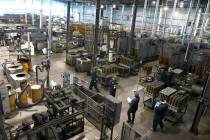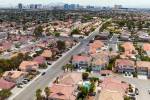Personal-income recovery heats up in Nevada
Nevada's lukewarm income recovery turned hot in 2015.
After nearly a decade bringing up the nation's rear in personal-income growth, the Silver State shot to No. 3 for gains in 2015, according to a new report from the Pew Charitable Trusts.
Barb Rosewicz, director of Pew's Fiscal 50 project, which produced the report, called the reversal "intriguing."
Faster income growth also provides a long-awaited "sense of stability coming out of the recession," said Brian Gordon, a principal of local economics and research firm Applied Analysis.
Personal income matters because federal agencies use the number to allocate funding for social services, while state governments check it to set budgets.
"It's an indicator that policymakers pay attention to as a key to what demands and resources might be," Rosewicz said.
But personal income is an important private-sector measure too: Growing incomes put more money into consumers' pockets for spending that spurs the broader economy, Gordon said.
From 2007 to 2014, Nevada didn't reap those advantages.
Nevada's total personal income fell 13 percent from the recession's beginning in 2007's fourth quarter to 2010's first quarter, when it bottomed out at $107.6 billion. The state took an especially large beating in earnings and wages, which make up half of personal income. It also struggled in business income and the category that includes dividend, interest and rental income. The only income groups that outpaced inflation in Nevada's downturn were business and government transfer payments, which include Social Security and public assistance programs such as Medicare and Medicaid.
Statewide personal income didn't return to its 2007 level of $123 billion until mid-2015, making Nevada the last state to complete the comeback, Rosewicz said.
From late 2007 to the third quarter of 2015, personal income was up 0.1 percent — the nation's worst performance.
Just four other states — Connecticut, Arizona, Maine and Illinois — posted income growth below 1 percent in the period. The U.S. average was 1.6 percent.
Nevada in particular struggled in the wage column. The state has ranked among the nation's top five for unemployment since 2010, including more than two years in the top spot. Nevada employers shed 170,000 jobs in the downturn, or about 13 percent of the state's jobs base.
Simply put, Nevada took so long to claw back because it dug itself the nation's biggest income hole, Gordon said.
Now, not only has personal income revived, it's on a growth tear.
The indicator surged 5 percent year to year in the third quarter, Pew's numbers showed. The growth rate ranked No. 3 in the nation, after California (5.5 percent) and Utah (5.4 percent).
Rosewicz traced the income gain partly to population growth, which has boosted spending in Nevada's economy. The Silver State's population grew 1.7 percent year over year in the third quarter, to nearly 2.9 million. The only state with faster population growth was North Dakota, where a still-solid energy sector drove a 2.1 percent jump in population. The national growth rate was 0.7 percent.
Improved activity in construction, health and social assistance also drove up Nevada's income total, Rosewicz said.
Wages and jobs have risen in several high-paying industries in particular, Gordon said.
Take construction. Average weekly hours worked in Nevada's building sector jumped from 33 hours in 2011 to 36.5 hours at the end of 2015, according to statistics from Applied Analysis. Job counts spiked 7.1 percent year over year in November, to 70,400 positions, based on numbers from the state Department of Employment, Training and Rehabilitation.
Employment in construction helps incomes because the industry's statewide average wage of $1,042 per week outpaces other categories, including leisure and hospitality at $481 and professional and business services at $796.
Despite recent strides, Gordon said he doesn't consider Nevada recovered.
"Gains over the last year have been relatively impressive, but if you think about a decade's worth of turmoil, the economy has yet to be cured from some of the fallout of the economic downturn," Gordon said. "The market has a ways to go before we're running at peak performance levels."
Still, Gordon said he expects labor shortages to put "upward pressure" on wages, and Nevada's population growth should stay at about 2 percent a year.
"The combination of those factors will help support above-average income growth going forward," he said.
— Contact Jennifer Robison at jrobison@reviewjournal.com. Follow @_JRobison on Twitter.




























